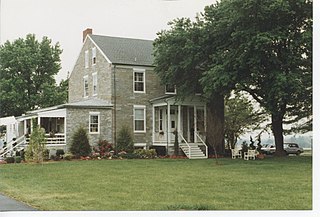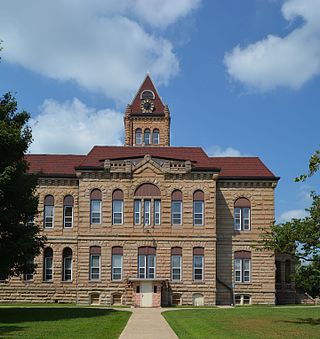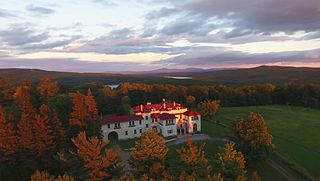
Henry Thomas Rainey was an American politician. A member of the Democratic Party from Illinois, he served in the United States House of Representatives from 1903 to 1921 and from 1923 to his death in 1934. He rose to Speaker of the House, during the famous Hundred days of Franklin D. Roosevelt in 1933.

Raphine is an unincorporated community in Rockbridge County in the Shenandoah Valley in the U.S. state of Virginia.

The Cyrus McCormick Farm and Workshop is on the family farm of inventor Cyrus Hall McCormick known as Walnut Grove. Cyrus Hall McCormick improved and patented the mechanical reaper, which eventually led to the creation of the combine harvester.

Boone Hall Plantation is a historic district located in Mount Pleasant, Charleston County, South Carolina, United States and listed on the National Register of Historic Places. The plantation is one of America's oldest plantations still in operation. It has continually produced agricultural crops for over 320 years and is open for public tours.

The Robert Allerton Park is a 1,517-acre (614 ha) park, nature center, and conference center located in the rural Piatt County township of Willow Branch, near Monticello, Illinois, on the upper Sangamon River. The park and manor house, The Farms, are attributed to owner Robert Allerton, industrialist heir, artist, art collector and garden designer. Robert donated the complex to the University of Illinois in 1946.

Carrollton Manor was a 17,000 acre (69 km2) tract of land in Frederick County, Maryland, United States, which extended from the Potomac River on the south, Catoctin Mountain to the west, the Monocacy River to the east, and Ballenger Creek to the north. It included the towns of Lime Kiln, Buckeystown, Adamstown, Doubs, Licksville, Tuscarora, and Point of Rocks.

Carrollton Courthouse Square Historic District is a historic district encompassing the courthouse square and surrounding commercial district in Carrollton, Greene County, Illinois. The district is centered on the Greene County Courthouse, a limestone Romanesque Revival building built in 1891–92. The courthouse occupies an entire city block at the center of the district. The twelve quarter blocks surrounding the courthouse comprise Carrollton's only business district. Development in the area began in 1821, when the first courthouse was built; at the time, the square was surrounded by new houses. The only house remaining from this period is the Hodges House, which was built in 1829 and is now a historical museum. The square assumed its commercial character between 1830 and 1855, when several brick stores were constructed. After 1855, the square gained several two- and three-story commercial buildings, which form the predominant type in the district. In addition to the commercial buildings, Carrollton's public library and post office are also located on the square.

The Greene County Almshouse is a historic poorhouse located in Greene County, Illinois, along a township road northeast of the city of Carrollton. The almshouse was built in 1870 in accordance with an 1839 state law which provided for each county to establish its own almshouse or poor farm for welfare recipients. Prior to passage of the law, public welfare in Illinois had taken the form of "outdoor relief", in which the poor worked on farms in exchange for basic support. Under Illinois' county almshouse system, the poor were intended to receive shelter and necessities in the houses, often in exchange for farm labor on the property. By 1903, all but two of Illinois' counties had established an almshouse or poor farm.

The Hodges House is a historic house located at 532 N. Main St. in Carrollton, Illinois, United States. The house was built circa 1825 and remodeled in the Federal style in 1829. Lawyer Charles D. Hodges purchased the house in 1850; soon afterward, he expanded the house and added Italianate features, such as the paired brackets along the roof line. Hodges served as a Greene County judge from 1853 until 1859, when he was elected to the U.S. House of Representatives to replace the deceased Thomas L. Harris. Hodges returned to his law practice when Harris' term ended later in 1859; he later served as a circuit judge and a state senator.

The Shrine of St. Anthony is a Roman Catholic shrine honoring St. Anthony of Padua. The shrine is located within the St. Joseph Cupertino Friary in Ellicott City, Maryland, USA. The shrine is a ministry of the Conventual Franciscan Friars, Our Lady of the Angels Province, USA.

Richland Farm is a historic home and farm complex located at Clarksville, Howard County, Maryland, United States. The main house is a log and frame house, the earliest section of which is presumed to date from 1719. The main block comprises three sections, with a large addition on the rear added in 1920. It features a one-story shed-roofed wrap-around porch supported by 22 Doric order columns. Also on the property are the Overseer's/Superintendent's House, Gardener's Cottage, wagon shed, tractor shed and smokehouse with board-and-batten siding, a bank barn, a stone spring house and “Barrack.”

Temple Hall is an early 19th-century Federal-style mansion and working farm near the Potomac River north of Leesburg in Loudoun County, Virginia.
Rainey House may refer to:

Seven Springs, situated on the Mehixen Swamp near the Pamunkey River in upper King William County, Virginia, is an historic home. Set in rolling farm country near the town of Manquin, the property lies within a community rich in colonial, revolutionary, and civil war history.

Winterham is a historic plantation house located near Winterham and Amelia Court House, Amelia County, Virginia, on Grub Hill Church Road. It was built about 1855 and is a two-story frame structure with a hipped roof in the Italian villa style. It has four original porches and a cross-hall plan. Also on the property are a contributing late 19th century farm dependency and early 20th century garage.

Aldworth Manor, also known as the Arthur E. Childs House, is a historic summer estate house in rural Harrisville, New Hampshire. The house is located at the top of a hill at the end of Aldworth Road, formerly the estate's access drive, and was one of the premiere estate houses of the early 20th century in the town. The house was originally built c.1850 in Worcester, Massachusetts. It was inherited by Arthur E. Childs, a Worcester native from a wealthy family, in the early 20th century.

The Black Homestead Farm is a historic farm located west of Carrollton in Greene County, Illinois. Margaret Black, one of the county's first settlers, established the farm in 1821. The farmhouse, built two years later, is the oldest surviving house in Greene County. Architect William Reay designed the brick Federal house, which features a symmetrical plan with evenly spaced windows, an oval fanlight above the original main entrance, and a gable roof with chimneys at each end. A new entrance with a Greek Revival porch was placed on the house in 1855. Other 19th-century farm buildings on the property include a smokehouse, wash house, carriage house, and horse barn. The farm raised livestock and grew grain through the 19th and 20th centuries, as was typical of Greene County farms; it still has active corn and soybean crops.

Norman Lemuel Jones was an American jurist and politician.

The Boudinot–Southard Farmstead is located at 135 North Maple Avenue in Bernards Township of Somerset County, New Jersey. The property was purchased by Elias Boudinot in 1771. Featuring a Colonial Revival farmhouse, it was added to the National Register of Historic Places on December 18, 2009, for its significance in agriculture, architecture, military and politics/government. The 37-acre (15 ha) farmstead includes four contributing buildings and two contributing structures. It is also known as the Ross Farm.



















